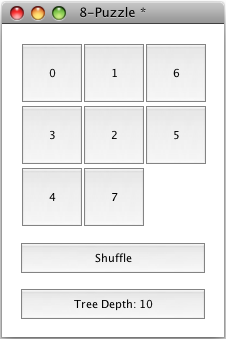
Solve the 8-Puzzle Game
Use Artificial Intelligence to solve the puzzle you created
by Hanson Schmidt-Cornelius
This lesson describes how to make the computer solve the 8-Puzzle for you, using a commonly applied Artificial Intelligence search technique. A top level discussion of the key algorithm is given, and code samples are provided.
Introduction
This follows on from our previous article Create an 8-Puzzle Game? and implements an Iterative Deepening Depth-First Search algorithm to solve the 8-Puzzle. The first article is an essential prerequisite for the information covered here. You should note however that the source code has been updated in this lesson, so to use a compatible code for the earlier part, please download the updated code here.
Iterative Deepening Depth-First Search is a well established Artificial Intelligence technique that is used to explore a search space in a relatively memory efficient way in order to find the shortest possible path, or in this case the least number of moves required to solve the 8-Puzzle. The key disadvantage of Iterative Deepening Depth-First Search is the nature by which it finds its solution. The time complexity is exponential, which means that the algorithm can become rather slow when having to solve long paths. In this particular example, the time to find a solution increases by a factor of approximately 2.7 for each additional move that is needed to solve the puzzle.
Let us put this information into perspective and assume we have three board states that have to be solved. Board state A can be solved in one move, board state B can be solved in 5 moves and board state C can be solved in 10 moves. In order to find the moves to these games, Iterative Deepening Depth-First Search has to explore approximately the following number of states for each game: A: 2.7 states, B: 143.5 states and C: 20589 states.
A whole range of other algorithms exist that are computationally faster for long paths, but these do not necessarily guarantee the shortest possible number of moves. Look at Heuristic Search if you are interested in alternative ways of solving the 8-Puzzle. An implementation of A* (A Star) will be investigated in the next edition of revUp.
Integrating the Functionality
Please update the openStack code from lesson How do I Create an 8-Puzzle Game? with the following openStack code. This adds a Solve button to the board and populates that button with the RevTalk script to run the Iterative Deepening Depth-First Search algorithm. Note that only one comment and one line of code have been added to the original openStack.
on openStack
# set up the constants for the game type
setGameConstants 3, 3
# remove any previous buttons that may already be on the card
# this prevents us from duplicating existing buttons
repeat while the number of buttons of this card > 0
delete button 1 of this card
end repeat
# create the board buttons
createBoard 50
# write the values onto the buttons
writeButtonLabels sWinningState
# create the space on the board
hide button ("b" & sSpaceButton)
# create the shuffle button
createShuffleButton
# create the solve button
createSolveButton
# make sure the board cannot be resized
set resizable of me to false
end openStack
Command createSolveButton creates the solve button and populates the script that is called when pressing the button. This command also resizes the card on which the game buttons and tiles are placed.
command createSolveButton
# create the shuffle button
new button
set label of button "New Button" to "Solve"
set width of button "New Button" to 60 * sTilesX + sOffset * (sTilesX - 1)
set location of button "New Button" to (60 * sTilesX + sOffset * (sTilesX - 1)) / 2 + 20, \
(60 * sTilesY + sOffset * (sTilesY - 1)) + 96
# populate the button script for the shuffle button
set the script of button "New Button" to \
"on mouseUp" & cr & \
"solvePuzzle 50" & cr & \
"end mouseUp"
set the name of button "New Button" to "Solve"
# resize the board for the buttons
set the width of me to 60 * sTilesX + sOffset * (sTilesX - 1) + 40
set the height of me to 60 * sTilesY + sOffset * (sTilesY - 1) + 126
end createSolveButton
Managing the Solution Process
Command solvePuzzle performs all steps needed to solve the 8-Puzzle. This includes testing whether or not the first board state is already the winning board state, calling Iterative Deepening Depth-First Search and moving the tiles back into the positions that are defined to be the solution state. pPadding specifies the amount of space that exists between the top and the left edge of the stack card and the grid of tiles.
command solvePuzzle pPadding
local tCurrentState, tPossibleMove, tMove, tDepth, tSolution
# get the current board state that needs to be solved
put boardToBoardState (pPadding) into tCurrentState
# iteratively deepen the search to find the shortest solution for the board state
if manhattanDistance (tCurrentState) is 0 then
answer "Puzzle is Already Solved!" with "OK"
else
repeat while tSolution is empty
put tDepth + 1 into tDepth
# update the solve button with search information
set label of button "Solve" to "Tree Depth: " & tDepth
# wait to ensure the label is updated
wait for 10 milliseconds
repeat with tPossibleMove = 0 to (sTilesX * sTilesY - 1)
put IDDFS (deriveNextState (tCurrentState, tPossibleMove, "8"), \
tPossibleMove, tDepth) into tSolution
if tSolution is not empty then
exit repeat
end if
end repeat
end repeat
# set the button label back to solve
set label of button "Solve" to "Solve"
# solve the board with the steps returned from the state space search algorithm
repeat for each word tMove in tSolution
swapButtons 8, tMove, 2
end repeat
answer "I Made It!" with "OK"
end if
end solvePuzzle
The Iterative Deepening Depth-First Search Algorithm
Function IDDFS is a short function that calls itself recursively in order to explore the search space. Within this function the logic performs three key tasks. 1. If we have found the winning state, then return the last tile that got us to this winning state. 2. If we have not found the winning state, call IDDFS again with a possible new move to explore. 3 If we are coming out of the recursion on the solution path then add the last tile that was moved to the list of moves that solve the puzzle.
The arguments passed to IDDFS are changed at each recursive call. pCurrentState specifies the current board state that is evaluated on this branch of the function call. pMove specifies the last move that was necessary to reach the current tile configuration that is defined by pCurrentState. pDepth is the current branch depth that must not be exceeded. This is used to control the iterative depth of the search.
function IDDFS pCurrentState, pMove, pDepth
local tPossibleMove, tSolution, tResult
put empty into tResult
if pCurrentState is not empty and pDepth is not 0 then
if manhattanDistance (pCurrentState) is 0 then
# if pCurrentState is the winning state
# then return the number of the tile that had to be moved to get here
put pMove into tResult
else
repeat with tPossibleMove = 0 to (sTilesX * sTilesY - 1)
# call IDDFS recursively with a new potential branch to explore
put IDDFS (deriveNextState (pCurrentState, tPossibleMove, "8"), \
tPossibleMove, pDepth - 1) into tSolution
if tSolution is not empty then
# if we are coming back out of the search tree and we are
# on the solution path then add the tile that was used to get
# us to this state to the moves on the solution path
put pMove & " " & tSolution into tResult
exit repeat
end if
end repeat
end if
end if
return tResult
end IDDFS
Deriving the Next Step
In order to explore a search space, IDDFS must know what the next branches of a particular tree node are. Function deriveNextState provides this information for a particular set of arguments.
pCurrentState is a node state for which a branch is to be found. pSwap1 and pSwap2 are tiles that should be swapped around in the resulting board state. If pSwap1 and pSwap2 cannot be swapped, then the result is empty.
function deriveNextState pCurrentState, pSwap1, pSwap2
local tHorizontal, tVertical, tButton1Horizontal, tButton2Horizontal, \
tButton1Vertical, tButton2Vertical, tResult
# get the x and y positions of the two buttons to be swapped,
# with respect to the horizontal and vertical game grid
put (wordOffset (pSwap1, pCurrentState) - 1) mod sTilesX into tButton1Horizontal
put (wordOffset (pSwap1, pCurrentState) - 1) div sTilesY into tButton1Vertical
put (wordOffset (pSwap2, pCurrentState) - 1) mod sTilesX into tButton2Horizontal
put (wordOffset (pSwap2, pCurrentState) - 1) div sTilesY into tButton2Vertical
# determine if the two buttons can be swapped
# if so create a new state that represents the swap
if ((tButton1Horizontal - tButton2Horizontal is 0) and \
(abs (tButton1Vertical - tButton2Vertical) is 1)) or \
((tButton1Vertical - tButton2Vertical is 0) and \
(abs (tButton1Horizontal - tButton2Horizontal) is 1)) then
put pCurrentState into tResult
replace pSwap1 with "X" in tResult
replace pSwap2 with pSwap1 in tResult
replace "X" with pSwap2 in tResult
else
put empty into tResult
end if
return tResult
end deriveNextState
The 8-Puzzle Board (Finding the Solution)
The button at the bottom of the game board states "Solve" in interactive playing mode. Once this button is selected, the text changes to "Tree Depth: X", indicating the depth at which the nodes are being explored. The tree depth "X" increments until a solution is found.
You can download the code associated with this article here.
|
About the Author
Hanson Schmidt-Cornelius is an experienced software developer with an interest in artificial intelligence.
|
| 


|




